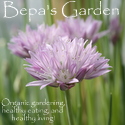It's been quite some time since I've posted anything, but now that fall is ever so slowly approaching and the gardens are just about done for the season, I am finding the ambition to sit down and write again.
We are still searching for our farmhouse in Vermont with enough land to start a small organic farm. While we aren't quite ready to move just yet (we still need to finish renovations and repairs on our current home), we seem to be getting closer to finding that perfect house. In the meantime I am trying to work with the space I have with my current property, and at the school garden, to feed my desire to farm!
One of the many reasons I garden is to try to grow as much of our own food as possible. Knowing that our food is grown organically, comes from open-pollinated or organic seeds, and is picked fresh and is nutritious means a lot. Nothing compares to freshly harvested and prepared food! What we don't grow, which seemed to be quite a lot this year, we try and get from local farmers.
Building a seed inventory is another goal of mine. I've been selecting varieties to grow out and save based on several different criteria including, flavor, variety, and regional history.
This year I tried growing Roy's Calais Red Flint Corn.
Here is a little bit of history (from slowfoodsusa.org):
"Roy's Flint Red Corn is an open-pollinated heirloom variety which was originally cultivated by the western Abenaki people in Vermont, and grown and maintained by pioneer farmers, including Roy and Ruth Fair of North Calais, VT. In 1996, Tom Searns obtained the seed from local farmers like Mike and Doug Guy, who had received the corn and seed saving information from Roy Fair. Tom Searns crossed all of the inbred strains and grew out the variety introducing it through his company, High Mowing Seeds of Wolcott, VT."
If you are interested in reading more about the history, click here.
Roy's Flint Red Corn is an heirloom variety that is said to be ideal for cornmeal, flour and hominy. It is an eight row flint variety that has a short growing season which is ideal for northern climates. According to Fruition Seeds, "it has a significantly higher amount of protein than other varieties of corn. It requires long cooking to break down the hard starch, but you will never go back to off the shelf polenta after this."
We had planted quite a few seeds at the school garden in hopes of doing an activity of grinding the corn into meal and making corn bread, but we ended up with fewer ears of corn than we had hoped for. We did however grow enough seed to over plant next year to try again growing this variety!
As you can see in the photos below, the variety of colors are truly fall-like and amazing.
We now have several pounds of seed for next year, and are planning on building the soil over the winter with either cover crops or compost and leaves, and amending again in the spring so there are plenty of nutrients available for this heavy feeding variety.
We are hopeful that next year we will be able to grow enough to grind to try making flour or cornmeal!
This will be another variety that will be added to my seed bank and grown out each year. It's very rewarding growing your own food, but it makes it even more meaningful when you are preserving a part of history and your food has a story behind it, something I hope to pass along to my children!
~Rob~




































